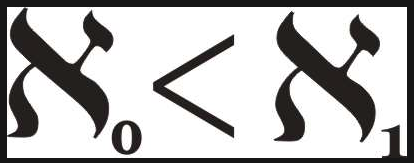I was doing my daily steem trawl, where I look through the newest posts to see if something interesting pops up, when I found a maths competition by @tradersharpe. So, here is my entry:
The problem is this: P is the set of all natural numbers; E is the set of all even numbers. Alice and Betty are arguing with Alice saying that P is larger than E and Betty saying that the two sets are the same size.
Of course, the answer is that they are the same. Betty is correct when she says this can be shown because, "The elements in P can be paired up with the elements in E."
Alice counters that there are some numbers in P that are not in E. This seems like a pretty good argument, at first. If one set has numbers that the other set has skipped over, then it seems to have extra numbers that aren't in the other set. However, this does not matter because we are considering the number of elements in the set, not what those elements are. What the actual elements are has no relation to the amount of elements. For instance, you could have positive numbers in one set and negative numbers in a second set. The two sets have no elements in common, and either set could be larger than the other, or they could be the same size. The point is that we cannot tell anything about the size of the set from looking at the individual contents.
A better way of looking at what is happening between P and E is that the elements in E are getting larger faster than the elements in P. If the sets had an upper bound, this would be a problem, as E would run out of values faster than P would. But, since there is no upper bound, for every element we count in P, we can also count one in E; it's just that the element in E will be larger.
As for history, the notion of infinity had been used in mathematics, such as calculus, where the slope of a curve is calculated by considering smaller and smaller sections of the curve until the section was infinitesimally small. But what infinity is actually made up of was first proposed by Georg Cantor in the l870s-1880s.
Cantor said that he had found two different sizes of infinity. He called them aleph null and aleph one; they are the weird symbols pictured above. Aleph null is the smaller type of infinity, and it's the type of infinity that Alice and Betty are discussing: both P and E are aleph null. This means that you can count the elements; you will never get to the end, but you can be sure that you're not missing any on the way.
| Count | 1 | 2 | 3 | 4 | 5 | ... |
|---|---|---|---|---|---|---|
| P | 1 | 2 | 3 | 4 | 5 | ... |
| E | 2 | 4 | 6 | 8 | 10 | ... |
You can see each number in both sets P and E line up with a counting number.
The other infinity is aleph one. This infinity is uncountable. An example of aleph one is the set of all real numbers. Considering that most real numbers are themselves infinitely long, there is just no way to line up all the decimals so they can be counted. I won't include the demonstration of this because it's not directly relevant to the question.
In conclusion, there are two types of infinity: countable and uncountable. Both P and E are examples of a countable infinity, so they are the same size.
!originalworks

